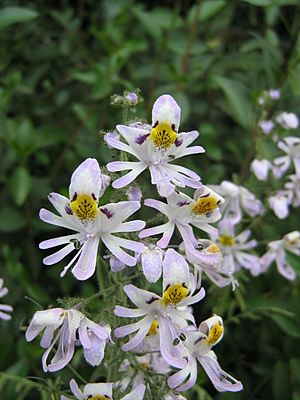Schizanthus facts for kids
Quick facts for kids Schizanthus |
|
|---|---|
 |
|
| Scientific classification |
|
| Kingdom: | Plantae |
| Clade: | Tracheophytes |
| Clade: | Angiosperms |
| Clade: | Eudicots |
| Clade: | Asterids |
| Order: | Solanales |
| Family: | Solanaceae |
| Subfamily: | Schizanthoideae |
| Genus: | Schizanthus Ruiz & Pav. |
| Species | |
|
See text |
|
Schizanthus, also known as the butterfly flower, fringeflower, or poor-man's-orchid, is a group of plants in the nightshade family, called Solanaceae.
These plants are usually annuals (live for one year) or biennials (live for two years). They are herbaceous, meaning they have soft stems, not woody ones. Their flowers are very pretty! Schizanthus plants are originally from Chile and Argentina. You can also find many species growing in other parts of the world, like New Zealand and the United States.
Contents
What Does the Butterfly Flower Look Like?
Schizanthus plants are annuals or biennials. They have sticky, hairy stems and leaves. Their leaves grow in a pattern where each leaf is divided into smaller parts, like a fern. The beautiful flowers grow at the end of the stems.
The flowers are zygomorphic, which means they can only be divided into two equal halves in one way, like a human face. They also have both male and female parts (they are hermaphroditic).
Each flower has 5 sepals (small leaf-like parts that protect the bud). The petals form a two-lipped shape. The top lip has three parts, and the bottom lip also has three parts. Inside the flower, there are usually 4 or 5 stamens (the male parts that produce pollen). The fruit is a small, round seed pod that opens to release many seeds.
Types of Butterfly Flowers
There are many different kinds of Schizanthus plants. Here are some of the species that scientists recognize:
- Schizanthus alpestris
- Schizanthus candidus
- Schizanthus grahamii
- Schizanthus hookerii
- Schizanthus integrifolius
- Schizanthus lacteus
- Schizanthus laetus
- Schizanthus litoralis
- Schizanthus parvulus
- Schizanthus pinnatus
- Schizanthus porrigens
- Schizanthus tricolor
Schizanthus litoralis
This plant is an annual that can grow up to 40 to 60 centimeters (about 1.5 to 2 feet) tall. It feels sticky and hairy. Its leaves are divided and can be 4 to 8 centimeters long. The leaves higher up on the stem are smaller.
The flowers are very colorful, often violet with yellow spots and a dark line. They grow in a cluster at the top of the stem. The fruit is a seed pod that is shorter than the sepals. This species is grown in the United States and Europe. It originally comes from the coast of Chile, where it is called "butterfly of the coast." Its seeds are a bit tricky to grow because they need to be scratched or rubbed to help them sprout.
Schizanthus pinnatus
This annual plant grows 20 to 50 centimeters (about 8 to 20 inches) tall and is also sticky and hairy. Its leaves are divided into many small segments. The flowers are white, pink, or violet and are about 2 to 3 centimeters wide. They grow in branched clusters.
The fruit is a round seed pod, about 5 millimeters long. This plant is native to Chile but is also grown as an ornamental plant. It is commonly known as the "small butterfly" or "small, white butterfly."
Schizanthus grahamii
This plant grows 30 to 50 centimeters (about 1 to 1.5 feet) tall and is sticky and hairy. Its leaves are divided and can be up to 8 centimeters long. The flowers can be violet, pink, orange, or white. The top part of the flower is longer than the bottom part.
The fruit is an oval-shaped seed pod, about 1 centimeter long. These plants are native to Chile and are also grown for their beauty. They usually flower in the summer.
Schizanthus × wisetonensis
This plant is a hybrid, meaning it's a mix of two different Schizanthus species: Schizanthus pinnatus and S. grahamii. It grows 30 to 40 centimeters tall and has features from both parent plants.
In some countries, it's called the "butterfly plant," and in English-speaking countries, it's often called "poor man's orchid." Its flowers are very pretty, coming in white, blue, pink, or rose colors depending on the type. The leaves are light green and look like fern leaves. This plant is grown as an ornamental all over the world in places with mild climates. It flowers in spring. These plants like mild, partly shaded spots because they don't do well in too much heat. New plants can be grown from seeds that ripen in the autumn. The seeds usually sprout in about 10–14 days if kept at 16-18 °C (61-64 °F).
How Butterfly Flowers Are Pollinated
Schizanthus plants are entomophilous, which means they need insects to carry their pollen from one flower to another. This is how they reproduce!
Most Schizanthus species are pollinated by insects like bees, bumblebees, and wasps. However, species with white flowers (like S. candidus, S. integrifolius, and S. lacteus) are pollinated by moths. Interestingly, Schizanthus grahamii is pollinated by hummingbirds!
Many plants in the nightshade family release pollen through small pores. But the Schizanthus species that are pollinated by bees use a special trick called explosive dehiscence. When an insect lands on the flower, it triggers the pollen to burst out, covering the insect. This helps make sure the pollen is carried to other plants, leading to cross pollination.
Special Chemicals in Butterfly Flowers
Alkaloids are natural chemicals made by plants. Even in small amounts, they can have strong effects on animals. Schizanthus plants contain many different types of alkaloids.
- Pyrrolidines: One example is found in Schizanthus integrifolius.
- Tropanes: Different types of tropanes have been found in various Schizanthus species, including Schizanthus alpestris, Schizanthus grahamii, Schizanthus hookerii, Schizanthus litoralis, and Schizanthus pinnatus.
- Schizantines: These are special types of tropane chemicals. For example, C, D, and E schizantines are found in Schizanthus grahamii. Schizanthus pinnatus has B and D schizantines, and Z schizantine is found in Schizanthus porrigens.
Other alkaloids found in these plants include 3-alpha-tigloyloxytropane, hygroline, and pseudohygroline. Scientists study these different alkaloids to understand how the Schizanthus genus has evolved over time.
How Butterfly Flowers Are Classified
Schizanthus includes 12 species of annual and biennial plants. They form their own special group within the nightshade family called Schizanthoideae. This group is considered the oldest branch of the Solanaceae family.
The History of Butterfly Flowers
Schizanthus is a unique group among nightshade plants because of its distinct flower shape and chromosome number. Scientists believe Schizanthus separated from the rest of the nightshade family a very long time ago, possibly 50 million years ago. At that time, the southern parts of South America had tropical or subtropical weather.
Even though the genus is very old, the main groups of Schizanthus species branched off more recently, about 5 million years ago. This was when the desert and semi-desert areas where these plants now live were already dry. The wide variety of flower types in Schizanthus is a result of the plants adapting to different types of pollinators in the various environments of Chile and Argentina.
Growing Butterfly Flowers
Schizanthus species are popular in horticulture and are widely grown as ornamental plants in gardens.
The flowers come in many colors and sizes. They often have delicate spots and blotches, making them look like small butterflies. A healthy plant can produce so many blooms that they completely cover it! For gardens, shorter varieties are often chosen because the taller ones can be a bit thin and crooked. The leaves are also attractive, with a soft green color, deeply cut edges, and a fern-like appearance, often covered in fine hairs.
A fun fact: This flower was used by Celia Sánchez during the Cuban Revolution to hide secret messages!
Many Schizanthus species are grown around the world, but Schizanthus × wisetonensis is perhaps the most popular. Some well-known types of this plant include "Angel Wings," "Disco," "Hit Parade," "Treasure Trove™ Lilac," "Treasure Trove™ Pure White," and "Treasure Trove™ Pure Scarlet Shades."
Protecting Butterfly Flowers
Conservation Efforts
Three species of Schizanthus (Schizanthus grahamii, Schizanthus hookeri, and Schizanthus pinnatus) are found in the Yerba Loca Nature Sanctuary in Chile. This is a protected area. This nature reserve is home to about 500 different types of plants. This means it protects a large part of the native plants found in the region.
See also
 In Spanish: Schizanthus para niños
In Spanish: Schizanthus para niños




